英语修辞法之矛盾修辞法,对照和警句
矛盾修辞法英语
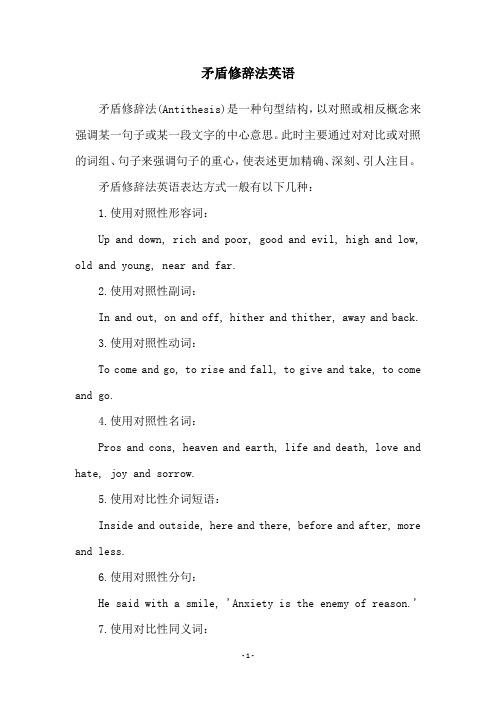
矛盾修辞法英语矛盾修辞法(Antithesis)是一种句型结构,以对照或相反概念来强调某一句子或某一段文字的中心意思。
此时主要通过对对比或对照的词组、句子来强调句子的重心,使表述更加精确、深刻、引人注目。
矛盾修辞法英语表达方式一般有以下几种:1.使用对照性形容词:Up and down, rich and poor, good and evil, high and low, old and young, near and far.2.使用对照性副词:In and out, on and off, hither and thither, away and back.3.使用对照性动词:To come and go, to rise and fall, to give and take, to come and go.4.使用对照性名词:Pros and cons, heaven and earth, life and death, love and hate, joy and sorrow.5.使用对比性介词短语:Inside and outside, here and there, before and after, more and less.6.使用对照性分句:He said with a smile, 'Anxiety is the enemy of reason.' 7.使用对比性同义词:He praised his teacher with a smile, 'Beauty and wisdom always go together.'8.使用对照性状语从句:His eloquence was matched by his knowledge, not to mention his wit and humor。
通过学习了解矛盾修辞法,我们可以更好的丰富英语表达,使文章更有色彩和情趣,展现出表达的活力和新意。
矛盾修辞法自我介绍英语
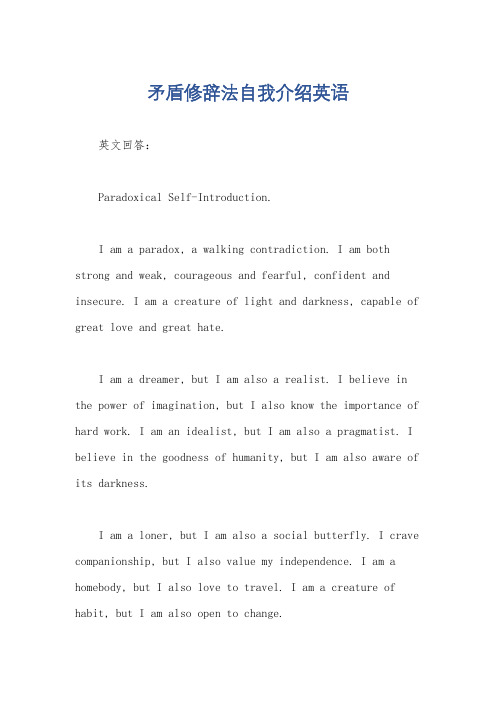
矛盾修辞法自我介绍英语英文回答:Paradoxical Self-Introduction.I am a paradox, a walking contradiction. I am both strong and weak, courageous and fearful, confident and insecure. I am a creature of light and darkness, capable of great love and great hate.I am a dreamer, but I am also a realist. I believe in the power of imagination, but I also know the importance of hard work. I am an idealist, but I am also a pragmatist. I believe in the goodness of humanity, but I am also aware of its darkness.I am a loner, but I am also a social butterfly. I crave companionship, but I also value my independence. I am a homebody, but I also love to travel. I am a creature of habit, but I am also open to change.I am a complex and contradictory creature, but I amalso a work in progress. I am always learning, always growing, and always changing. I am not perfect, but I am striving to become the best version of myself that I can be.中文回答:自我矛盾的自我介绍。
英语修辞及举例说明

They call for you: the general who became a slave; the slave who became a gladiator; the gladiator who defied an Emperor They have promised to finish the work and finish it they will.
Hale Waihona Puke 仿拟是学习英文格言美句的好办法,在仿拟 的过程中, 还可以对固有的词组和谚语进行创新 和改动,以达到修辞的效果。
Lady hermits who are down but not out (down and out 穷困潦倒) 穷困而不潦倒的女隐士们。
蝉联(anadiplosis) 是重复(repetition)一种变形,即在后一句 的开头重复前句末尾的词语。
换称 antonomasia
是借代的一种,所不同的是英语换称中所用的专有名词通 常源于西方宗教、历史以及文学作品中的专有名词或者形 象。如: Solomon 所罗门------a wise man 聪明人, 出自圣经 Judas 犹大------ a traitor 叛徒,出自圣经 Helen 海伦----------红颜祸水,美女海伦为斯巴达王的王后, 因她被帕里斯拐去而引起特洛伊战争。 Venus 维纳斯--------Beauty 美的化身,出自古希腊神话。 Reform is a Pandora’s box; opening up the system can lead to a loss of economic and political control.
Metaphor 暗喻 对两种具有共同特征的事物或现象进行对比;所 不同的是在形式上,暗喻中本体和喻体之间多通 过Be 动词来联系。省掉比喻词。 明喻:Life is like an unexplored river, full of twists and turns, great beauty and dangerous surprises . 暗喻: Life is an unexplored river, full of twists and turns, great beauty, and dangerous surprises.
英语中矛盾修辞法的应用

• •
又如: 肖金铉道:“今日对名花,聚良朋,不可无诗。我们即席分韵,何如?”杜慎 卿笑道:“先生,这是而今诗社里的故套,小弟看来,觉得雅的这样俗 雅的这样俗,还是 雅的这样俗 清淡为妙。” 这里”雅”与“俗”是矛盾的。为了强调“俗”,作者以表面上的“雅”来 衬托之。幽默讽刺,令人玩味。
•
• • • • • • • • • •
英语中矛盾修辞法的应用与翻译
矛盾修饰法(oxymoron)是英语中一种常用的修辞手法。oxymoron源于 希腊文oxusmoros.oxus 意为sharp; moros意为foolish,stupid,dull。而 oxymoron的意思是pointed foolish 或sharp foolish. 矛盾修辞法是有意识地运用语义反常(semantic anomaly)现象,把含 有对立或矛盾语义成分的词语联系到一起以造成出语奇险的一种修辞手 段,它能产生特殊的、引人注目、意味深长、妙趣横生、幽默讽刺的修 辞效果。这种修辞手法在十六世纪末和十七世纪曾用得很普遍。
• • • • • • • • • •
著名的例子可见莎士比亚笔下的《罗密欧与朱丽叶》。例如: Juliet: Beautiful tyrant! Fiend angelical! Dove-feather’d raven! Wolfish-ravening Iamb! … A damned saint,an honourable villain! 英俊的幕君!天使般的恶魔! 披着白鸽羽毛的乌鸦!豺狼般残忍的羔羊! ! ! …… 一个万恶的圣人,一个庄严的奸徒! 罗密欧与朱丽叶两家世代为仇,在一次械斗中,朱丽叶的表哥提伯尔 特杀死了茂丘西奥,罗密欧愤怒之下杀死了提伯尔特为其至友复仇。 朱丽叶闻讯后悲愤交加,因不明真相而说出了以上一连串的诅咒语。 这里用的全是矛盾修辞法,把朱丽叶指骂的对象那种表面道貌岸然实 质内心奸诈的形象表述得淋滴尽致,充分显示其修辞效果。
英语矛盾修饰法例句
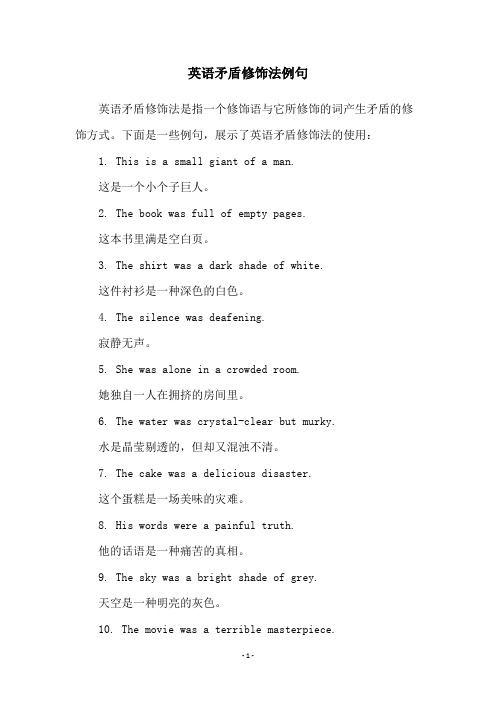
英语矛盾修饰法例句
英语矛盾修饰法是指一个修饰语与它所修饰的词产生矛盾的修饰方式。
下面是一些例句,展示了英语矛盾修饰法的使用:
1. This is a small giant of a man.
这是一个小个子巨人。
2. The book was full of empty pages.
这本书里满是空白页。
3. The shirt was a dark shade of white.
这件衬衫是一种深色的白色。
4. The silence was deafening.
寂静无声。
5. She was alone in a crowded room.
她独自一人在拥挤的房间里。
6. The water was crystal-clear but murky.
水是晶莹剔透的,但却又混浊不清。
7. The cake was a delicious disaster.
这个蛋糕是一场美味的灾难。
8. His words were a painful truth.
他的话语是一种痛苦的真相。
9. The sky was a bright shade of grey.
天空是一种明亮的灰色。
10. The movie was a terrible masterpiece.
这部电影是一部可怕的杰作。
英文中最常见的20种修辞手法(解释例句)
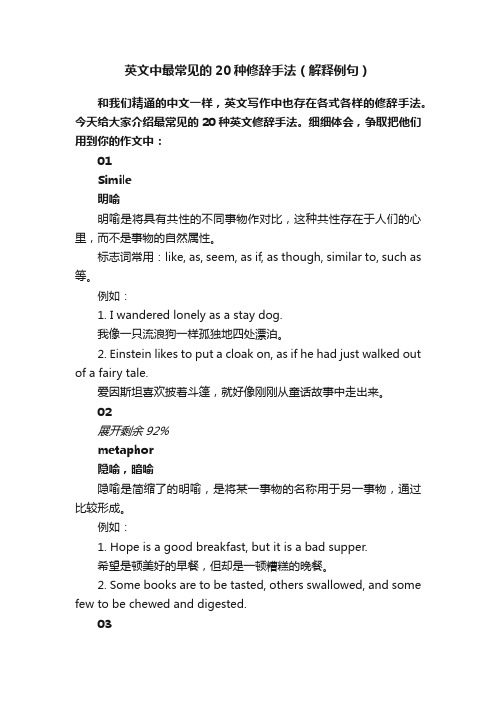
英文中最常见的20种修辞手法(解释例句)和我们精通的中文一样,英文写作中也存在各式各样的修辞手法。
今天给大家介绍最常见的20种英文修辞手法。
细细体会,争取把他们用到你的作文中:01Simile明喻明喻是将具有共性的不同事物作对比,这种共性存在于人们的心里,而不是事物的自然属性。
标志词常用:like, as, seem, as if, as though, similar to, such as 等。
例如:1. I wandered lonely as a stay dog.我像一只流浪狗一样孤独地四处漂泊。
2. Einstein likes to put a cloak on, as if he had just walked out of a fairy tale.爱因斯坦喜欢披着斗篷,就好像刚刚从童话故事中走出来。
02展开剩余92%metaphor隐喻,暗喻隐喻是简缩了的明喻,是将某一事物的名称用于另一事物,通过比较形成。
例如:1. Hope is a good breakfast, but it is a bad supper.希望是顿美好的早餐,但却是一顿糟糕的晚餐。
2. Some books are to be tasted, others swallowed, and some few to be chewed and digested.03metonymy借喻,转喻借喻不直接说出所要说的事物,而使用另一个与之相关的事物名称.1. 以容器代替内容,例如:1)The kettle boils.水开了。
2)The room sat silent.全屋人安静地坐着。
2. 以资料、工具代替事物的名称,例如:Lend me your ears, please.请听我说。
3. 以作者代替作品,例如:a complete Shakespeare莎士比亚全集4. 以具体事物代替抽象概念,例如:I had the muscle, and they made money out of it.我有力气,他们就用我的力气赚钱。
英语中的矛盾修饰法
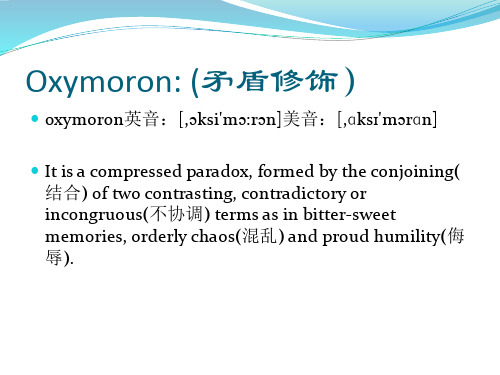
6 v. + adv. shine darkly 暗淡地发光 die merrily 快乐地死去 hasten slowly 慢慢地快起来 groan loudly 大声地呻吟
7 of-phrase the feather of lead 铅铸的羽毛 the sound of silence 沉默的声音
2.加强语势。起强调作用。 构成矛盾关系的两个词一般属于修饰和被修饰的关系, 所以往往强调了被修饰词.例如:
An atmosphere of dangerous calm could be felt throughout the mining region.
为了渲染气氛.加强语势,作者用dangerous来修饰calm, 给人以一种很不平静的感觉,从而使这种“平静”得到
Note: The difference between paradox and oxymoron In paradox, it is sentence meaning that is contradictory (句子含义矛盾); In oxymoron, it is words meaning that is contradictory (词汇含义矛盾).
地未出席会议。
4 n. + n. a love-hate relationship 又爱又恨的关系 a life-and-death struggle 生死存亡的斗争
5 adv. + present participle changelessly changing 不变地变化 deliciously aching 令人愉快地疼痛
4) The mother is undergoing the joyful pain, and the painful joy of childbirth.
英语31修辞手法及例句
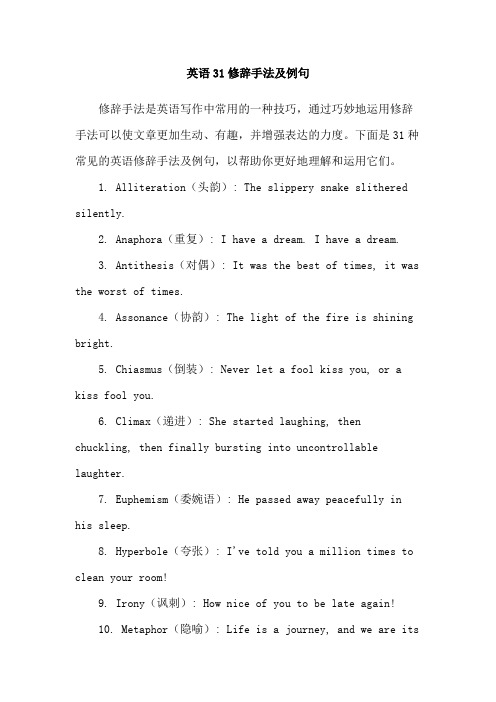
英语31修辞手法及例句修辞手法是英语写作中常用的一种技巧,通过巧妙地运用修辞手法可以使文章更加生动、有趣,并增强表达的力度。
下面是31种常见的英语修辞手法及例句,以帮助你更好地理解和运用它们。
1. Alliteration(头韵): The slippery snake slithered silently.2. Anaphora(重复): I have a dream. I have a dream.3. Antithesis(对偶): It was the best of times, it was the worst of times.4. Assonance(协韵): The light of the fire is shining bright.5. Chiasmus(倒装): Never let a fool kiss you, or a kiss fool you.6. Climax(递进): She started laughing, then chuckling, then finally bursting into uncontrollable laughter.7. Euphemism(委婉语): He passed away peacefully in his sleep.8. Hyperbole(夸张): I've told you a million times to clean your room!9. Irony(讽刺): How nice of you to be late again!10. Metaphor(隐喻): Life is a journey, and we are itspassengers.11. Onomatopoeia(拟声): The bees buzzed by my ear.12. Oxymoron(矛盾修饰): The silence was deafening.13. Parallelism(并列结构): She likes cooking, swimming, and reading.14. Personification(拟人): The flowers danced in the wind.15. Pun(双关): I used to be a baker, but I couldn't make enough dough.16. Repetition(重复): I must do it. I will do it. I can do it.17. Rhetorical question(修辞疑问): Who can resist the aroma of freshly baked bread?18. Simile(明喻): Her smile is as bright as the sun.19. Synecdoche(提喻法): The pen is mightier than the sword.20. Allusion(典故): She had a Mona Lisa smile on her face.21. Apostrophe(呼唤): Oh, love, why do you torment me so?22. Consonance(协音): The ship has sailed to the farthest shores.23. Enjambment(跨行): I wandered lonely as a cloudThat floats on high o'er vales and hills.24. Litotes(婉言): She is not unkind.25. Metonymy(转喻): The pen is mightier than the sword.26. Paradox(悖论): The more you know, the more you don't know.27. Periphrasis(迂回说法): The city that never sleeps (New York City).28. Sarcasm(讽刺): Oh, you're so clever, I can hardly stand it.29. Symbolism(象征): The dove represents peace.30. Understatement(轻描淡写): It's just a little cut, no need to make a fuss.31. Zeugma(两义): She lost her keys and her temper.这些修辞手法在英语写作中非常常见,它们可以使文章更加生动有趣,同时也能够增强表达的力度。
英语19种修辞手法的全部解释和例句 英语中有19种修辞手法

英语19种修辞手法的全部解释和例句英语中有19种修辞手法,它们分别是:Simile明喻、Metaphor 隐喻,暗喻、Metonymy 借喻,转喻、Synecdoche 提喻、Synaesthesia 通感,联觉,移觉、Personification 拟人、Hyperbole 夸张、Parallelism 排比,平行、Euphemism 委婉,婉辞法、Allegory 讽喻,比方、Irony 反语、Pun 双关、Parody 仿拟、Rhetorical question 修辞疑问、Antithesis 对照,对比,对偶、Paradox 隽语、Oxymoron 反意法,逆喻、Climax 渐进法,层进法、Anticlimax 渐降法。
下面和大家分享一下这19种修辞手法的全部解释和例句,快来学习吧!1.Simile 明喻明喻是将具有共性的不同事物作对比。
这种共性存在于人们的心里,而不是事物的自然属性。
标志词常用like, as, seem, as if, as though, similar to, such as等。
例如:1>.He was like a cock who thought the sun had risen to hear him crow。
2>.I wandered lonely as a cloud。
3>.Einstein only had a blanket on, as if he had just walked out of a fairy tale。
2.Metaphor 隐喻,暗喻隐喻是简缩了的明喻,是将某一事物的名称用于另一事物,通过比较形成。
例如:1>.Hope is a good breakfast, but it is a bad supper。
2>.Some books are to be tasted, others swallowed, and some few to be chewed and digested。
高级英语修辞手法总结归纳

高级英语修辞手法总结归纳修辞是语言使用中的重要技巧,通过巧妙运用各种修辞手法,能使语言表达更为生动、有力或富有韵味。
以下是对常见的高级英语修辞手法的总结归纳:一、隐喻与明喻隐喻是将一个词或短语用来暗示另一个事物,而明喻则是直接将一个事物与另一个事物进行比较。
例如,“他像一只狮子一样勇猛”(明喻)和“爱情是一座城堡”(隐喻)。
二、拟人及拟物拟人是赋予非生物或抽象事物以人的特性,而拟物则是赋予人或动物以非生物的特性。
例如,“河流唱着轻快的歌曲”(拟人)和“他的怒火如野兽般狂暴”(拟物)。
三、排比与对偶排比是将三个或以上结构相似、意义相近的词、短语或句子并列使用,以增强语势。
对偶则是将意义相对或相反的词、短语或句子进行对比,以突出主题。
例如,“生命在于运动,死亡在于静止”(对偶)和“他跨越了山岭,穿越了沙漠,走过了平原”(排比)。
四、反复与交错反复是将相同的词、短语或句子重复使用,以强调某种情感或主题。
交错则是将不同的词、短语或句子相互交替使用,以达到特定的表达效果。
例如,“永远、永远、永远不要放弃”(反复)和“是与否,对与错”(交错)。
五、借代与提喻借代是用一个事物的某一部分来代替整体或其他部分,而提喻则是用整体来代替某一部分或用类属来代替个体。
例如,“我要用笔墨写下永恒”(借代)和“人是一本书”(提喻)。
六、反讽与戏谑反讽是通过说反话或正话反说来达到讽刺的效果,戏谑则是用幽默诙谐的语言来戏弄或嘲笑某人或某事。
例如,“他是一个天生的傻瓜”(反讽)和“爱情是人生的蜜糖”(戏谑)。
七、矛盾修辞法矛盾修辞法是将相互矛盾的概念或形象结合在一起,以引起读者的思考或表达复杂的情感。
例如,“孤独的狂欢”,“死亡的生命”。
八、头韵与脚韵头韵是使用相同或相似的音韵开头,脚韵是使用相同或相似的音韵结尾。
例如,“美丽的美女”(头韵)和“生活是一首歌”(脚韵)。
九、夸张与弱化夸张是通过夸大事实或形象来强调某种情感或主题,弱化则是通过缩小事实或形象来淡化某种情感或主题。
英语常用修辞格分类

英语常用修辞格分类Figures of SpeechSimile (明喻):Wrong ideas may harm man just like diseases.Her face is as white as a paper.Metaphor (暗喻):He is the soul of the team.My desk is flooded with paper.There are a few lordly poplars before the house.The charcoal fire glowed and dimmed rhythmically to the stroke of the bellows. Personification (拟人):The leaves are trembling in the cold wind.Metonymy (转喻,借代):His unfriendly tongue surprised her.The grey hair should be respect.Synecdoche (提喻,部分整体):The farms were short of hands during the harvest season.They share the same roof.England won the football.Euphemism (委婉):He unfortunately passed away last year.He is out visiting the necessary.Irony (反语):You are a fine goalkeeper, allowing the other side to score six goals. Overstatement/hyperbole (夸大的叙述):Thanks a million.She wept oceans of tears.His anger nearly burst his belly.His friends praised his daughter’s performance to the skies.She eats like a bird.Understatement (保守的陈述):“What do you think of the roast duck?” “Not bad.”He has got heart trouble, but it is nothing serious.Transferred epithet (转移修饰语):The old man put a reassuring hand on my shoulder.He crashed down on a protesting chair.Oxymoron (矛盾修饰法):She read the long-awaited letter with a tearful smile.Parting is such a sweet sorrow.Alliteration (头韵):Time and tide wait for no man.Pun (双关):They pray for you today and prey on you tomorrow.Women have a wonderful sense of right and wrong, but little sense of right and left.Customer: Waiter, will the pancakes be long? -Waiter: No, sir, round.In the window of a hearing-aid shop: “Trust us, over 5000 ears (years) of experience.”-Why can you never expect a fisherman to be so generous?-Because his business makes him sell fish (selfish).Analogy (类比):Knowledge is to the mind what nutrition is to the body.Antonomasia (换称, 专有名词代普通名词,人名、地名):He spent the whole winter in the Windy City. (Chicago)Shanghai is the New York of China.Allusion (暗示):Grammar may be his heel of Achilles.语法是他的大弱点。
矛盾修饰法

矛盾修饰法矛盾修饰法(Oxymoron)是将两个互相矛盾,互不调和,的词放在同一个短语中,产生特殊的深刻含义的一种修辞手段。
用它来状物写景,能突出事物的实质;用它来描绘人物,能使其更加鲜明;用它来表达复杂的思想感情或意味深长的哲理,能使其更强烈,更深刻。
它是一种紧缩隽语。
矛盾修饰法是将两个意思截然不同的词放在一起,结合成一个词组,而对语是通过平行结构引起两个概念的对比。
矛盾修饰法:从哲学上讲,是对立的统一;从艺术上讲,更能体现出描写主体的个性化,更具渲染力。
例如:1.a clever fool聪明的傻瓜2.a victorious defeat胜利的失败3.cruel kindness残酷的仁慈4.expressionless expression毫无表情的表情5.sick health憔悴的健康6.a living death行尸走肉7.with careful carelessness小心翼翼又漫不经心地8.bright and dark既光彩夺目,又朦胧黑暗9.dove-feather’d raven披着白鸽羽毛的乌鸦10.with her disagreeably pleasant laugh(她)自鸣得意却令人讨厌地笑起来11. an honorable villain体面的恶棍12.There was an audible stillness, in which the common voice soundedstrange.(from Sister Carrie by Theodore Dreiser)这时是一片听得见的寂静,连人声听起来都是异样的。
(选自美国作家西奥多·德莱塞的长篇小说《嘉莉妹妹》)(作者用audible来修饰stillness,匠心独具地从反面烘托环境,使人耳目一新,过目难忘。
矛盾的对立面取得了高度的一致,形成了完美的统一。
)矛盾修饰法:名言警句及分析1、Every white habits black, and every sweet habits sour.(白中有黑,甜里带酸)在这句谚语中,使用了两组反义词“white”与“black”;“sweet”与“sour”,强烈的对比表现了世界万物对立统一、互相依存的哲学思辨以及酸甜苦辣交织的人生百味。
容易混淆的英语修辞的区分

对比和矛盾修辞法对照或对比(antithesis)It is the deliberate arrangement of contrasting words or ideas in balanced structural forms to achieve emphasis. For example, speech is silver; silence is golden. 是一种将结构相同或基本相同、意义完全相反的语句排列在一起,以达到加强效果的修辞手法。
Be slow to promise and quick to perform允诺宜缓,履行宜速。
Pride hurts, modesty benefits. 满招损,谦受益。
To know oneself is wisdom, to forget oneself is folly. 自知之明是智慧,忘乎所以是愚蠢。
以上从快与慢、满与谦、智慧与愚蠢的矛盾对立方面来说,意思相反相成、对立统一,揭示了深刻的人生哲理。
同时4)句promise和perform运用了头韵修辞法,使该句富有节律,朗朗上口。
矛盾修辞法 Oxymoron: (矛盾修饰) It is a compressed paradox, formed by the conjoining(结合) of two contrasting, contradictory or incongruous(不协调) terms asin bitter-sweet memories, orderly chaos(混乱) and proud humility(侮辱).用两种不调和、甚至截然相反的特征来形容一项事物,在矛盾中寻求哲理,以达到修辞效果。
它是反论的一种浓缩形式。
Though he lost the game, actually it was a victorious defeat.移就和拟人拟人(personification) It gives human form of feelings to animals, or life and personal attributes(赋予) to inanimate(无生命的) objects, or to ideas and abstractions(抽象). For example, the wind whistled through the trees.这种修辞方法是把人类的特点、特性加于外界事物之上,使之人格化,以物拟人,以达到彼此交融,合二为一。
英语中所有26种修辞手法的全部解释和例句

英语修辞手法总结Figures of speech (修辞)are ways of making our language figurative. When we use words in other than their ordinary or literal sense to lend force to an idea, to heighten effect, orto create suggestive imagery, we are said to be speaking or writing figuratively. Now we are going to talk about some common forms of figures of speech.1) Simile:(明喻)It is a figure of speech which makes a comparison between two unlike elements having at least one quality or characteristic (特性)in common. To make the comparison, words like as, as...as, as if and like are used to transfer the quality we associate with one to the other. For example, As cold waters to a thirsty soul, so is good news from a far country.2) Metaphor:(暗喻)It is like a simile, also makes a comparison between two unlike elements, but unlike a simile, this comparison is implied rather than stated. For example, the worldis a stage.3) Analogy: (类比)It is also a form of comparison, but unlike simile or metaphor which usually uses comparison on one point of resemblance, analogy draws a parallel between two unlike things that have several common qualities or points of resemblance.4) Personification: (拟人)It gives human form of feelings to animals, or life and personal attributes(赋予) to inanimate(无生命的) objects, or to ideas and abstractions(抽象). For example, the wind whistled through the trees.5) Hyperbole: (夸张) It is the deliberate use of overstatement or exaggeration to achieve emphasis. For instance, he almost died laughing.6) Understatement: (含蓄陈述) It is the opposite of hyperbole, or overstatement. Itachieves its effect of emphasizing a fact by deliberately(故意地) understating it,impressing the listener or the reader more by what is merely implied or left unsaid than by bare statement. For instance, It is no laughing matter.7) Euphemism: (委婉) It is the substitution of an agreeable or inoffensive(无冒犯) expression for one that may offend or suggest something unpleasant. For instance, we refer to "die" as " pass away".8) Metonymy (转喻)It is a figure of speech that has to do with the substitution of the mane of one thing for that of another. For instance, the pen (words) is mightier than the sword (forces).9) Synecdoche (提喻) It is involves the substitution of the part for the whole, or thewhole for the part. For instance, they say there's bread and work for all. She was dressedin silks.10) Antonomasia (换喻)It has also to do with substitution. It is not often mentioned now, though it is still in frequent use. For example, Solomon for a wise man. Daniel for a wise and fair judge. Judas for a traitor.11) Pun: (双关语) It is a play on words, or rather a play on the form and meaning of words. For instance, a cannon-ball took off his legs, so he laid down his arms. (Here "arms" has two meanings: a person's body; weapons carried by a soldier.)12) Syllepsis: (一语双叙) It has two connotations.In the first case, it is a figure by which a word, or a particular form or inflection of a word, refers to two or more words in the same sentence, while properly applying to or agreeing with only on of them in grammar or syntax(句法). For example, He addressed you and me, and desired us to follow him. (Here us is used to refer to you and me.)In the second case, it a word may refer to two or more words in the same sentence. For example, while he was fighting , and losing limb and mind, and dying, others stayed behind to pursue education and career. (Here to losing one's limbs in literal; to lose one's mindis figurative, and means to go mad.)13) Zeugma: (轭式搭配) It is a single word which is made to modify or to govern two or more words in the same sentence, wither properly applying in sense to only one of them, orapplying to them in different senses. For example, The sun shall not burn you by day, nor the moon by night. (Here noon is not strong enough to burn)14) Irony: (反语) It is a figure of speech that achieves emphasis by saying the opposite of what is meant, the intended meaning of the words being the opposite of their usual sense. For instance, we are lucky, what you said makes me feel real good.15) Innuendo: (暗讽) It is a mild form of irony, hinting in a rather roundabout (曲折)way at something disparaging(不一致) or uncomplimentary(不赞美) to the person or subject mentioned. For example, the weatherman said it would be worm. He must take his readings in a bathroom.16) Sarcasm: (讽刺) It Sarcasm is a strong form of irony. It attacks in a taunting and bitter manner, and its aim is to disparage, ridicule and wound the feelings of the subject attacked. For example, laws are like cobwebs, which may catch small flies, but let wasps break through.17) Paradox: (似非而是的隽语) It is a figure of speech consisting of a statement or proposition which on the face of it seems self-contradictory, absurd or contrary to established fact or practice, but which on further thinking and study may prove to be true, well-founded, and even to contain a succinct point. For example more haste, less speed.18) Oxymoron: (矛盾修饰) It is a compressed paradox, formed by the conjoining(结合) of two contrasting, contradictory or incongruous(不协调) terms as in bitter-sweet memories, orderly chaos(混乱) and proud humility(侮辱).19) Antithesis: (对照) It is the deliberate arrangement of contrasting words or ideas in balanced structural forms to achieve emphasis. For example, speech is silver; silence is golden.20) Epigram: (警句) It states a simple truth pithily(有利地) and pungently(强烈地). It is usually terse and arouses interest and surprise by its deep insight into certain aspects of human behavior or feeling. For instance, Few, save the poor, feel for the poor.21) Climax: (渐进) It is derived from the Greek word for "ladder" and implies the progression of thought at a uniform or almost uniform rate of significance or intensity,like the steps of a ladder ascending evenly. For example, I came, I saw, I conquered.22) Anti-climax or bathos: (突降)It is the opposite of Climax. It involves stating one's thoughts in a descending order of significance or intensity, from strong to weak, from weighty to light or frivolous. For instance, But thousands die, without or this or that, die, and endow(赋予) a college, or a cat.23) Apostrophe: (顿呼) In this figure of speech, a thing, place, idea or person (dead or absent) is addressed as if present, listening and understanding what is being said. For instance, England! awake! awake! awake!24) Transferred Epithet: (转类形容词) It is a figure of speech where an epithet (anadjective or descriptive phrase) is transferred from the noun it should rightly modify(修饰) to another to which it does not really apply or belong. For instance, I spent sleeplessnights on my project.25) Alliteration: (头韵) It has to do with the sound rather than the sense of words for effect. It is a device that repeats the same sound at frequent intervals(间隔) and since the sound repeated is usually the initial consonant sound, it is also called "front rhyme". For instance, the fair breeze blew, the white foam flew, the furrow followed free.26) Onomatopoeia: (拟声) It is a device that uses words which imitate the sounds made by an object (animate or inanimate), or which are associated with or suggestive(提示的) of some action or movementExplanation version1一、什么是修辞格修辞格(figures of speech)是提高语言表达效果的语言艺术。
高级英语修辞总结

Rhetorical Devices一、明喻(simile)是以两种具有相同特征的事物和现象进行对比,表明本体和喻体之间的相似关系,两者都在对比中出现。
常用比喻词like, as, as if, as though等,例如:1、This elephant is like a snake as anybody can see.这头象和任何人见到的一样像一条蛇。
2、He looked as if he had just stepped out of my book of fairytales and had passed me like a spirit.他看上去好像刚从我的童话故事书中走出来,像幽灵一样从我身旁走过去。
3、It has long leaves that sway in the wind like slim fingers reaching to touch something.它那长长的叶子在风中摆动,好像伸出纤细的手指去触摸什么东西似的。
二、隐喻(metaphor)这种比喻不通过比喻词进行,而是直接将用事物当作乙事物来描写,甲乙两事物之间的联系和相似之处是暗含的。
1、German guns and German planes rained down bombs, shells and bullets... 德国人的枪炮和飞机将炸弹、炮弹和子弹像暴雨一样倾泻下来。
2、The diamond department was the heart and center of the store.钻石部是商店的心脏和核心。
三、Allusion(暗引)其特点是不注明来源和出处,一般多引用人们熟知的关键词或词组,将其融合编织在作者的话语中。
引用的东西包括典故、谚语、成语、格言和俗语等。
英语引用最多的是源出《圣经》故事以及希腊、罗马神话、《伊索寓言》和那些源远流长的谚语、格言等。
例如:1、Grammar may be his heel of Achilles.语法是他的大弱点。
oxymoron矛盾修饰法例句
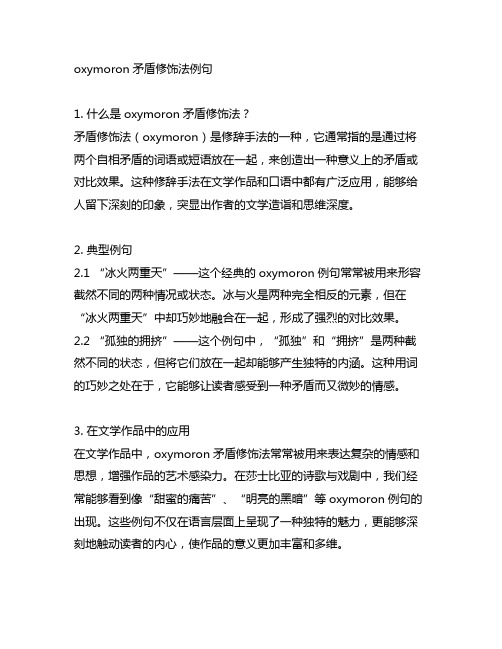
oxymoron矛盾修饰法例句1. 什么是oxymoron矛盾修饰法?矛盾修饰法(oxymoron)是修辞手法的一种,它通常指的是通过将两个自相矛盾的词语或短语放在一起,来创造出一种意义上的矛盾或对比效果。
这种修辞手法在文学作品和口语中都有广泛应用,能够给人留下深刻的印象,突显出作者的文学造诣和思维深度。
2. 典型例句2.1 “冰火两重天”——这个经典的oxymoron例句常常被用来形容截然不同的两种情况或状态。
冰与火是两种完全相反的元素,但在“冰火两重天”中却巧妙地融合在一起,形成了强烈的对比效果。
2.2 “孤独的拥挤”——这个例句中,“孤独”和“拥挤”是两种截然不同的状态,但将它们放在一起却能够产生独特的内涵。
这种用词的巧妙之处在于,它能够让读者感受到一种矛盾而又微妙的情感。
3. 在文学作品中的应用在文学作品中,oxymoron矛盾修饰法常常被用来表达复杂的情感和思想,增强作品的艺术感染力。
在莎士比亚的诗歌与戏剧中,我们经常能够看到像“甜蜜的痛苦”、“明亮的黑暗”等oxymoron例句的出现。
这些例句不仅在语言层面上呈现了一种独特的魅力,更能够深刻地触动读者的内心,使作品的意义更加丰富和多维。
4. 在口语中的应用除了在文学作品中的应用之外,oxymoron矛盾修饰法在口语中也有着广泛的运用。
人们常常会在日常交流和表达中使用这种修辞手法,以增强语言的表达力和生动性。
我们经常会听到类似“无声的喧嚣”、“无味的美食”、“甜蜜的痛苦”等oxymoron例句的使用。
这些例句能够使语言更具传神,同时也能够引起听者对语言背后意义的深入思考。
5. 总结oxymoron矛盾修饰法作为一种修辞手法,能够在文学作品和口语表达中发挥重要的作用。
它通过将两种截然相反的词语或短语放在一起,创造出一种独特的意义和效果,从而增强了语言的表达力和感染力。
无论是在文学创作中,还是在日常交流中,我们都可以发现oxymoron矛盾修饰法的踪迹,它已经成为了丰富语言表达的重要组成部分。
英语中种修辞手法的全部解释和例句
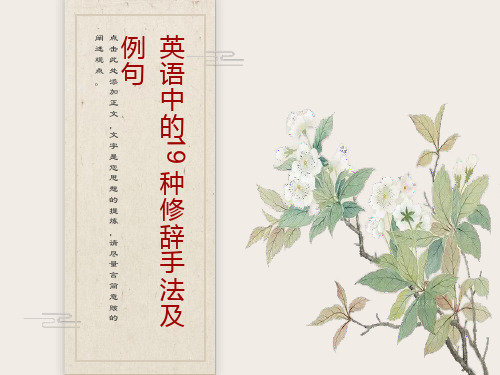
10.Allegory 讽喻,比方(原意“寓言”)
STEP4
STEP3
STEP2
STEP1
这是一种源于希腊文的修辞法,意为"换个方式的说法".它是一种形象的描述,具有双重性,表层含义与真正意味的是两回事.
Make the hay while the sun shines.
:趁着出太阳的时候晒草。
4.Synecdoche 提喻
提喻用部分代替全体,或用全体代替部分,或特殊代替一般. 例如: 1>.There are about 100 hands working in his factory.(部分代整体) 他的厂里约有100名工人. 2>.He is the Newton of this century.(特殊代一般) 他是本世纪的牛顿. 3>.The fox goes very well with your cap.(整体代部分) 这狐皮围脖与你的帽子很相配.
11.Irony 反语
双关就是用一个词在句子中的双重含义,借题发挥.作出多种解释,旁敲侧击,从而达到意想不到的幽默.滑稽效果.它主要以相似的词形.词意和谐音的方式出现.
.If we don't hang together, we shall hang separately.
12.Pun 双关
例如:
例如:
Hope is a good breakfast, but it is a bad supper.
Some books are to be tasted, others swallowed, and some few to be chewed and digested.
2.Metaphor 隐喻,暗喻
英文修辞手法与例句
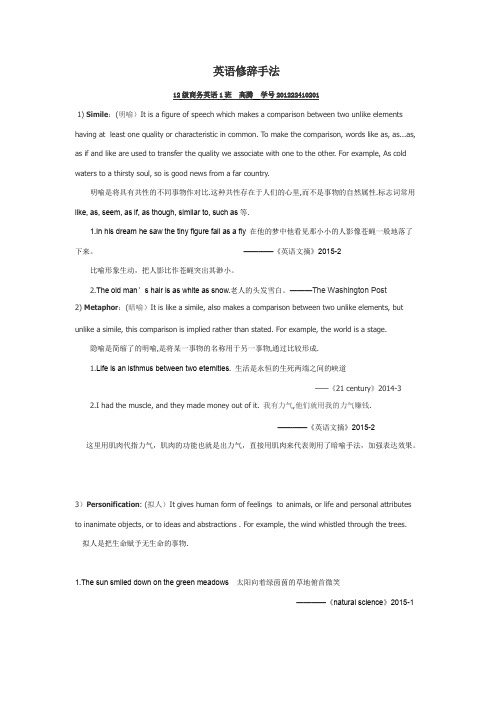
英语修辞手法12级商务英语1班高腾学号2012224102011)Simile:(明喻)It is a figure of speech which makes a comparison between two unlike elements having at least one quality or characteristic in common.To make the comparison,words like as,as...as, as if and like are used to transfer the quality we associate with one to the other.For example,As cold waters to a thirsty soul,so is good news from a far country.明喻是将具有共性的不同事物作对比.这种共性存在于人们的心里,而不是事物的自然属性.标志词常用like,as,seem,as if,as though,similar to,such as等.1.In his dream he saw the tiny figure fall as a fly在他的梦中他看见那小小的人影像苍蝇一般地落了下来。
————《英语文摘》2015-2比喻形象生动,把人影比作苍蝇突出其渺小。
2.The old man’s hair is as white as snow.老人的头发雪白。
2)Metaphor:(暗喻)It is like a simile,also makes a comparison between two unlike elements,but unlike a simile,this comparison is implied rather than stated.For example,the world is a stage.隐喻是简缩了的明喻,是将某一事物的名称用于另一事物,通过比较形成.1.Life is an isthmus between two eternities.生活是永恒的生死两端之间的峡道——《21century》2014-32.I had the muscle,and they made money out of it.我有力气,他们就用我的力气赚钱.————《英语文摘》2015-2这里用肌肉代指力气,肌肉的功能也就是出力气,直接用肌肉来代表则用了暗喻手法,加强表达效果。
- 1、下载文档前请自行甄别文档内容的完整性,平台不提供额外的编辑、内容补充、找答案等附加服务。
- 2、"仅部分预览"的文档,不可在线预览部分如存在完整性等问题,可反馈申请退款(可完整预览的文档不适用该条件!)。
- 3、如文档侵犯您的权益,请联系客服反馈,我们会尽快为您处理(人工客服工作时间:9:00-18:30)。
4. I saw a film yesterday. It is called a True Lie.
5. She loved him so much that she wanted to revenge against him for this love-hate relationship.
9. If a free society cannot help the many who are poor, it cannot save the few who are rich.
10. Look before you leap. 11. After a storm comes calm. 12. Art is long, but life is short. 13. Well begun is half done.
16. The wicked flee when no one pursues, but the righteous are bold as a lion.
17. Men always want to be a woman’s first love; women have a more subtle instinct, what they like is to be a man’s last romance.
1.That building is a little bit big and pretty ugly.
2.This woman had known the hot whispers of a manly. And that she had answered, fiercely soft.
14. A mother takes twenty years to make a man of her boy, and another woman makes a fool of him in twenty minutes.
15. To be prepared for war is one of the most effectual means of preserving peace.
6. He is really a lovely fat little big boy.
7. Back and forth his head swiveled, desire waxing, resolution waning.
8. United, we stand, divided, we fall.
